

3 Tips for Creating Effective Online Courses. Due to the onset of COVID-19, many corporations have had to transform the way in which they train and engage their employees and customers.
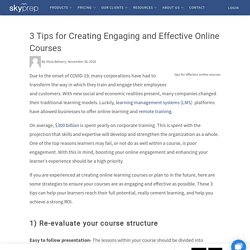
With new social and economic realities present, many companies changed their traditional learning models. Luckily, learning management systems (LMS) platforms have allowed businesses to offer online learning and remote training. On average, $300 billion is spent yearly on corporate training. This is spent with the projection that skills and expertise will develop and strengthen the organization as a whole. One of the top reasons learners may fail, or not do as well within a course, is poor engagement. 4 Tips for Engaging Virtual Learners. By Ehsan Memari, December 24, 2020 Virtual learning can sometimes be challenging for learners to stay engaged and attentive.
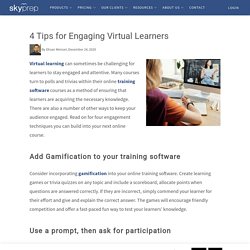
Many courses turn to polls and trivias within their online training software courses as a method of ensuring that learners are acquiring the necessary knowledge. There are also a number of other ways to keep your audience engaged. Read on for four engagement techniques you can build into your next online course. Add Gamification to your training software. The Three Critical Aspects For Creating Engaging eLearning. The Three Critical Aspects For Creating Engaging eLearning. Missing Learner Engagement In Your eLearning? 5 Ways To Bring It In. Wallflowers in the Online Classroom. What does it mean to be a wallflower?
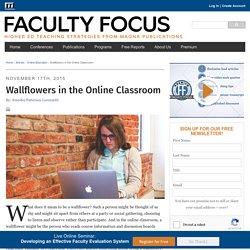
Such a person might be thought of as shy and might sit apart from others at a party or social gathering, choosing to listen and observe rather than participate. And in the online classroom, a wallflower might be the person who reads course information and discussion boards regularly, but never posts. So how do instructors know if this online wallflower is really engaged in the course? Angelique Hamane of Pepperdine University knows something about being a wallflower.
“I learn from the periphery,” she says, noting that she knows all about popular restaurants from perusing Yelp, and that she’s a “virtual doctor” thanks to regular surfing of WebMD. A great deal of research supports the understanding that student engagement is linked to student success. 3 Tips for Creating Effective Online Courses. Encouraging Online Learner Participation. Sustained, high-quality student participation usually doesn’t happen on its own in the online learning environment.

The instructor needs to model participation, create assignments that encourage it, and foster an environment that supports it. Here are some ways that I promote student participation in my online courses. Use discussions as assignments. Rather than assigning an overall participation grade, I treat each one-to-two-week discussion as an assignment. The discussion assignment is typically tied to an independent assignment. I find that students do not necessarily need much preparation to interact in these discussion forums after I model participation for them.
Create informal conversation spaces. The Teacher’s Room is for administrative issues and questions and comments about current and past assignments. Encourage and recognize go-getters. Use student moderators. Student Engagement Strategies for the Online Learning Environment. During the past year and a half, our faculty development unit has been gathering data from students about how engaged they felt in their online courses.
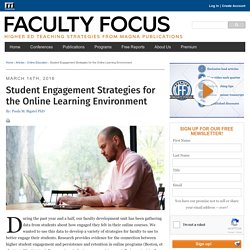
We wanted to use this data to develop a variety of strategies for faculty to use to better engage their students. Research provides evidence for the connection between higher student engagement and persistence and retention in online programs (Boston, et al., 2010; Wyatt, 2011). Encouraging student engagement is especially important in the online environment where attrition rates are higher than in the face-to-face setting (Allen & Seaman, 2015; Boston & Ice, 2011). Synchronous Online Classes: 10 Tips for Engaging Students. There’s a widely circulated YouTube video you may have seen called “A Conference Call in Real Life.”
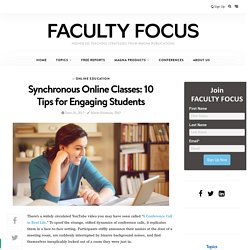
To spoof the strange, stilted dynamics of conference calls, it replicates them in a face-to-face setting. Participants stiffly announce their names at the door of a meeting room, are suddenly interrupted by bizarre background noises, and find themselves inexplicably locked out of a room they were just in. Engaging Students in Online Courses: Adding Experiential to Asynchrony. Teaching online is a unique experience for faculty and students.
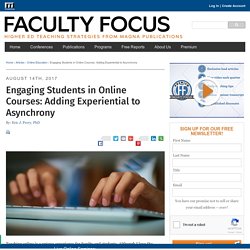
Although I love the online environment for some courses, it does present its own challenges. One of those challenges is how to engage online students in activities that push them to go beyond simply reading, interpreting, and interacting. After all, the idea (in most cases) is that the student can apply their learning, knowledge, and skills in their respective fields of study.
As such, we are constantly seeking ways to engage students in learning that goes beyond the “click-through” material. In this article, I share a few ideas—starting with the simplest and working through some more complicated endeavors—that may assist you in bringing more engagement to your online classroom. Keeping Students on Board with Concept Maps. The benefits of concept maps are well established.
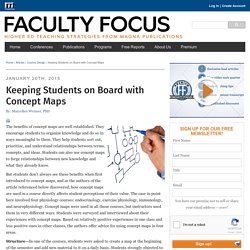
They encourage students to organize knowledge and do so in ways meaningful to them. They help students sort out, prioritize, and understand relationships between terms, concepts, and ideas. Students can also use concept maps to forge relationships between new knowledge and what they already know. But students don’t always see these benefits when first introduced to concept maps, and as the authors of the article referenced below discovered, how concept maps are used in a course directly affects student perceptions of their value. How to Get Your Students to Come to Class Prepared.
Imagine a world where students came to class prepared.
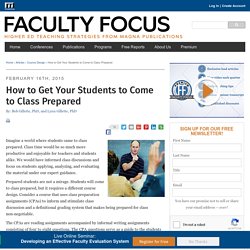
Class time would be so much more productive and enjoyable for teachers and students alike. We would have informed class discussions and focus on students applying, analyzing, and evaluating the material under our expert guidance. Prepared students are not a mirage. Students will come to class prepared, but it requires a different course design. Consider a course that uses class preparation assignments (CPAs) to inform and stimulate class discussion and a definitional grading system that makes being prepared for class non-negotiable. The CPAs are reading assignments accompanied by informal writing assignments consisting of four to eight questions.
The CPAs are graded pass-fail only. In a definitional grading system the pedagogical assumption is that different categories of work are each important, and the teacher does not want one category to compensate for the other in any way. Grading the CPAs is easy. J. Four Types of Group Work Activities to Engage Students. Collaboration helps to develop many of the key skills that will be required of students for their future success.
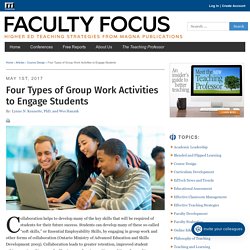
Students can develop many of these so-called “soft skills,” or Essential Employability Skills, by engaging in group work and other forms of collaboration (Ontario Ministry of Advanced Education and Skills Development 2005). Collaboration leads to greater retention, improved student achievement, and increased self-esteem and metacognition, and it can be used to facilitate active learning and to promote inclusion by increasing contact among diverse groups (Bossert 1988; Bowman, Frame, and Kennette 2013; Hennessey 1999; Kennette and Frank 2010; Kramarski and Mevarech 2003; Rajaram and Pereira-Pasarin 2007; U.S. Department of Education 1992). Despite the many benefits of group work, instructors are sometimes hesitant to use it due to some of its well-known pitfalls (social loafing, disputes, individualized grading, student bemoaning, etc.). References Bossert, S. Cortright, R. Synchronous Online Classes: 10 Tips for Engaging Students. An Activity That Promotes Engagement with Required Readings, Even in Large Classes.
On the first day of class, I often say something like this to my students: “Nothing floats my boat more than great discussion. Nothing promotes great discussion like having completed the readings. And nothing promotes completing the readings like having points attached to it.” Encouraging students to complete the course readings is an age-old problem. When I was a graduate student, Douglas Sprenkle, now a professor emeritus at Purdue University, used a primary and secondary reaction discussion format that inspired thrilling class discussions.
Years before discussion boards, Professor Sprenkle divided the class into two groups that alternated between serving as primary and secondary reactors to weekly readings. However, making this approach work in large classes was much more challenging. Ashley Harvey is an associate professor and a senior teaching faculty member in the Department of Human Development and Family Studies at Colorado State University. © Magna Publications. Pause, Play, Repeat: Using Pause Procedure in Online Microlectures. We all know the classic thought experiment involving a tree falling in the woods, but have you heard the one about online lecturing: If a faculty member posts a microlecture video to the LMS, and students view it, has learning occurred? While we may never know if a falling tree makes a sound, we can determine whether students are engaging with our microlectures by applying the principles of pause procedure. Pause procedure incorporates many of the best practices when it comes to online and active learning, including creating instructor presence, emphasizing metacognition, and aligning with outcomes-based learning.
7 Tips for Increasing Student Engagement in Online Courses. Most educators will agree that student engagement is paramount for a high quality learning experience. Not everyone agrees on what is meant by student engagement or how to achieve it. One definition of student engagement is “the amount, type, and intensity of investment students make in their educational experiences.”